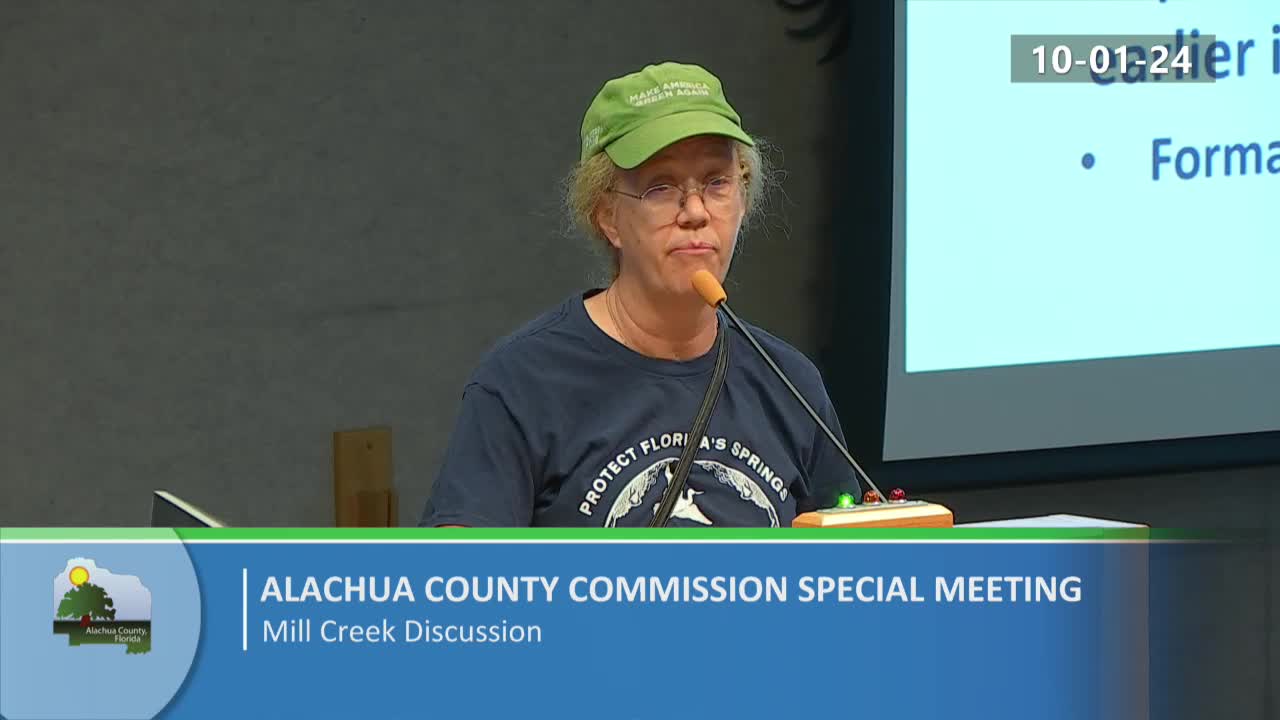Residents Rally Against High Density Development Threatening Water Supply
October 01, 2024 | Alachua County, Florida
This article was created by AI summarizing key points discussed. AI makes mistakes, so for full details and context, please refer to the video of the full meeting. Please report any errors so we can fix them. Report an error »

Residents of Alachua County expressed deep concerns during a recent government meeting regarding the potential environmental impacts of a proposed high-density development near sensitive water systems. Community members, including local environmental advocates and business owners, highlighted the risks posed to well water, sinkhole formation, and the overall health of the Santa Fe River ecosystem.
One resident, who identified as the Sierra Club chair of the conservation committee, emphasized the inadequacy of the city's stormwater treatment systems, arguing that they would not effectively mitigate runoff issues, particularly in light of recent heavy storms. The speaker urged local officials to communicate these limitations to the city of Alachua, stressing the need for more robust solutions to prevent sinkholes and protect the water supply.
Dennis Price, a geologist with extensive experience in the region, echoed these concerns, warning that the proposed development's location on a sensitive slope could exacerbate sinkhole risks. He recounted past incidents where similar developments led to significant environmental damage, urging caution and thorough investigation before proceeding.
Joanne Tremblay, president of the Santa Fe River organization, pointed out that the proposed high-density housing would increase impermeable surfaces, leading to greater runoff and further impairing local springs that feed into the Santa Fe River. She called for a reduction in development density and a reevaluation of the project’s environmental impact.
Residents also voiced worries about the implications for their own water quality, with many relying on wells for their drinking water. Concerns were raised about the potential for increased sinkhole activity and the long-term sustainability of local water resources, particularly given the area's karst geology, which is prone to such geological issues.
Mayor Catherine Weitz of High Springs highlighted the challenges faced by homeowners in managing sinkholes, noting that existing homeowners' associations often lack the resources to address these issues effectively. She called for proactive measures to protect the municipal water supply, emphasizing the need for careful planning and oversight.
The meeting underscored a growing tension between development interests and environmental protection, with residents advocating for a more cautious approach to land use that prioritizes the health of local ecosystems and water resources. As discussions continue, community members remain vigilant, urging local officials to consider the long-term implications of their decisions on the environment and public health.
One resident, who identified as the Sierra Club chair of the conservation committee, emphasized the inadequacy of the city's stormwater treatment systems, arguing that they would not effectively mitigate runoff issues, particularly in light of recent heavy storms. The speaker urged local officials to communicate these limitations to the city of Alachua, stressing the need for more robust solutions to prevent sinkholes and protect the water supply.
Dennis Price, a geologist with extensive experience in the region, echoed these concerns, warning that the proposed development's location on a sensitive slope could exacerbate sinkhole risks. He recounted past incidents where similar developments led to significant environmental damage, urging caution and thorough investigation before proceeding.
Joanne Tremblay, president of the Santa Fe River organization, pointed out that the proposed high-density housing would increase impermeable surfaces, leading to greater runoff and further impairing local springs that feed into the Santa Fe River. She called for a reduction in development density and a reevaluation of the project’s environmental impact.
Residents also voiced worries about the implications for their own water quality, with many relying on wells for their drinking water. Concerns were raised about the potential for increased sinkhole activity and the long-term sustainability of local water resources, particularly given the area's karst geology, which is prone to such geological issues.
Mayor Catherine Weitz of High Springs highlighted the challenges faced by homeowners in managing sinkholes, noting that existing homeowners' associations often lack the resources to address these issues effectively. She called for proactive measures to protect the municipal water supply, emphasizing the need for careful planning and oversight.
The meeting underscored a growing tension between development interests and environmental protection, with residents advocating for a more cautious approach to land use that prioritizes the health of local ecosystems and water resources. As discussions continue, community members remain vigilant, urging local officials to consider the long-term implications of their decisions on the environment and public health.
View full meeting
This article is based on a recent meeting—watch the full video and explore the complete transcript for deeper insights into the discussion.
View full meeting